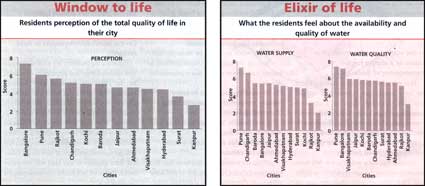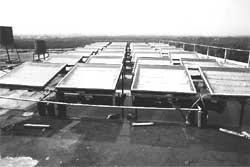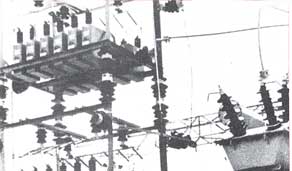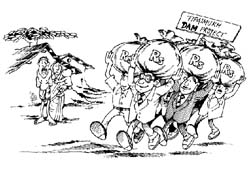History sheet
From producing yeast to vaccines and life saving drugs, microbial research has come a long way
From producing yeast to vaccines and life saving drugs, microbial research has come a long way

Are you happy with your city? The International Finance and Trade Centre, Ahmedabad, tried to find an answer to this question from after surveying 100 upper-income households in 12 Indian cities to

The Taiwanese government has earned the wrath of the Yami people residing in the Orchid Islands - 62 km east of the country's southern tip - for dumping of nuclear waste for 14 long years by the
A new system will allow the hearing impaired to respond to vibrations and alert them about incoming calls
<table width="100" border="0" style="font-family:Arial, Helvetica, sans-serif; font-size:12px" align="left"> <tr> <td> <img src="files/images/20080315/52.jpg" border="0"></td> </tr> <tr> <td><font color="#660000"><b>V K J RANE</b></font></td> </tr> </table> The Mumbai metro looks set to run on standard gauge tracks. The Union Ministry of Railways had recommended the broad gauge system, but the Mumbai Metropolitan Regional Development Authority deemed the narrower standard gauge system suitable for Mumbai's geography. Not everybody is pleased with the decision.

Electronic firms see a hot market in solar power generation systems

The Power Finance Corp has recently initiated a programme to enhance energy efficiency by installing capacitors to harness the reactive load in transmission systems
General Motors and Ford said Monday they would cut North American vehicle production in response to weakening demand, especially for big sport-utility vehicles and pick-up trucks. Five of the six biggest carmakers reported a drop in February car and light truck sales in spite of more generous discounts and other incentives. Even demand for Toyota's Prius petrol-electric hybrid hatchback slipped 10 per cent. General Motors announced a 12.9 per cent fall in light vehicle sales compared with February 2007. Toyota, which overtook Ford last year as the number-two carmaker in the US, saw a 2.7 per cent drop. Ford's sales were 6.9 per cent lower. Chrysler and Nissan also reported declines. The exception was Honda, which gained 4.9 per cent. There were was one more selling day last month than in February 2007. According to Autodata, a market research firm, total light vehicle sales fell to a seasonally adjusted annual rate of 15.4 million units in February from 16.6 million a year earlier. Mark LaNeve, GM's vice-president for North American sales, said: "Traffic was soft, business was tough all month.' He added that tightening credit conditions were affecting sales "on the margin'. Sales of the Chevrolet Silverado pick-up, GM's top-selling vehicle, slumped 28 per cent. The pick-up market has been especially vulnerable to the slump in housebuilding. Edmunds.com, an online pricing service, estimated that carmakers raised incentives by an average 8.4 per cent last month compared to a year earlier. Toyota raised its incentives 40 per cent to more than $1,000 a vehicle. The company shrugged off the drop in Prius sales, ascribing it to record demand last February at the start of a special promotion. GM's incentives, totalling $3,315, were almost a quarter higher, diluting its drive over the past two years to wean itself from these promotions. Jim Farley, Ford's marketing chief, said: "The industry as a whole will be under more pricing pressure.' GM said it planned to cut second-quarter production 5 per cent. Ford announced a 10 per cent reduction. Honda's performance underlined a move towards small cars and crossover vehicles, which look like SUVs but are built on car platforms. Edmunds.com, said Honda spent more on incentives than Toyota last month, a rare event. Separately, GM announced the promotion of Fritz Henderson, chief financial officer, to president and chief operating officer. Ray Young, vice-president of finance and head of GM Brazil, succeeds Henderson as chief financial officer.
BHARAT NIRMAN: Allocation increased to Rs 31,280 crore against Rs 24,603 crore in 2007-08. Bharat Nirman, the flagship programme of the UPA government for rural infrastructure, with a cost of Rs 1,74,000 crore and a fast approaching deadline of 2009, got an allocation of Rs 31,280 crore this Budget. The highlight this year is the increase in allocation for rural housing. Bharat Nirman targets six development components, viz rural access to housing, roads, drinking water, telephony, electrification and irrigation. For the rural housing scheme, called Indira Awas Yojana, which benefits only those who have land, the Budget provides an increased subsidy for building houses under the programme. The government subsidy of Rs 25,000 crore for houses in the plains will now increase to Rs 35,000 crore. The public sector banks have been asked to give up to Rs 20,000 in loans at an interest of 4 per cent for the Indira Awas Yojana houses. About 6 million houses are targeted to be built under the programme by 2009. So far, 5.1 million houses have been constructed, according to Finance Minister P Chidambaram. OUTLAYS vs OUTCOMES Expenditure is up, education is not % children who can Class Read* Subtract Divide 1 3 3.9 1.5 2 9 14.2 3.7 3 21.6 31.1 11.2 4 42.5 34.7 27.6 5 58.7 31.9 42.4 6 71.7 27.8 54.2 7 79.7 23.4 62.8 8 86.6 18.3 71.6 Average 41.6 23.1 30.1 Note: Children who can divide can subtract as well Source: Pratham 2007 * Read a Class 2 text The allocation of Rs 5,400 crore for rural housing is up from Rs 4,400 crore last year. Bharat Nirman, as a whole, received Rs 31,280 crore, compared to Rs 24,603 crore in 2007-08. Bharat Nirman's component on drinking water, implemented through the Rajiv Gandhi Drinking Water Mission, got another feature under the Budget with the finance minister allocating a separate amount of Rs 200 crore for providing drinking water in schools. The allocation for the scheme has also been enhanced from Rs 6,500 crore last year to Rs 7,300 crore this year. The Budget was silent on rural access to telephony under Bharat Nirman except saying that 52 villages were getting access to telephone, well ahead of the target. The scheme targets reaching over 66,000 villages by 2009 and can progress at a rate of 45 houses per day. The Rajiv Gandhi Grameen Vidyutikaran Yojana, which aims at providing electricity connections to all villages by 2009, has been allocated Rs 5,500 crore this year. Access to irrigation under Bharat Nirman got a fillip with the Accelerated Irrigation Benefit Programme allocations getting almost doubled from Rs 11,000 crore to Rs 20,000 crore. Under the programme, 24 major and medium irrigation projects and 753 minor irrigation projects will be completed in this financial year, creating an irrigation potential of 500,000 hectares. The scheme targets 10 million hectares. While six million hectares are to be covered under major and medium projects, one million hectares are to be brought under micro irrigation. Chidambaram said that 548,000 hectares were brought under drip and sprinkler irrigation since 2006, while, with a budgetary allocation of Rs 500 crore, 400,000 hectares were being targeted for coverage this year.
A bag full of surprises: Madhya Pradesh Finance Minister Raghavji arrives at the Vidhan Sabha in Bhopal to present the State Budget on Wednesday. Finance Minister Raghavji on Wednesday presented in the State Assembly the Madhya Pradesh Budget for 2008-09 with a budgetary deficit of Rs.91.43 crore. The Minister announced a reduction in entry tax on raw material inputs for textile industry and removal of entry tax on sponge iron and iron scrap for induction furnace. He also announced a reduction in VAT on diesel from 26 per cent to 25 per cent. Mr. Raghavji went on to announce pension and medical facilities to those detained under the dreaded MISA (Maintenance of Internal Security Act) during the infamous Emergency. Those who served six months or more behind bars would get Rs.6,000 per month as "Loknayak Jayaprakash Samman Nidhi' (monthly pension) while there would be a pension of Rs.3,000 for those jailed for more than three months but less than six months. One of the major budgetary announcements was that wheat would be available to each BPL family at the rate of Rs.3 per kg and rice at Rs.4.50 per kg . The budget for 2008-09 has a revenue surplus of Rs.2839.78 crore and the fiscal deficit for year is estimated at Rs.4741.00 crore, which is 3 per cent of the GSDP. The Finance Minister told media persons later that one of the important goals was to focus attention on gender budgeting to ensure equality for women, economic empowerment and women's participation in developmental schemes covered by 21 State departments. The Budget provides Rs.1371.47 crore for Energy, Rs.1656 crore for construction of roads and Rs.484 crore for road maintenance. The Finance Minister incorporated the Chief Minister's recent announcements at a Kisan Mahapanchayat here and told the House that there would be budgetary provision for a bonus of Rs.100 per quintal of wheat procured by government agencies for the public distribution system, reduction in rate of interest from 7 per cent to 5 per cent on short-term agriculture loans, relief in payment of old outstanding electricity bills, and increase in the rate of grant from 10 per cent to 30 per cent on drip/sprinkler irrigation. Mr. Raghavji said that additional irrigation capacity for 4.80 lakh hectare had been created in last four-year period and for the next fiscal, there would be a provision of Rs.1815.57 crore for irrigation purpose. He said colleges of excellence would be set up in each of the 38 backward districts. He also told the House that 254 girls' hostels would be constructed and 448 middle schools would be upgraded to the high school level. The Government would also be launching several scholarships for students belonging to the weaker sections, he added. The Finance Minister told the House that there was provision of Rs.566.88 crore (State share) for creation of employment in rural areas, Rs.100 crore for the District Poverty Initiative Programme Phase-II and Rs.93.23 crore for Rural Livelihood Project. He said the State employees would get dearness allowance and dearness relief at the rate of 4 per cent from this coming April 1 onward.
Cash-rich Haryana has earmarked Rs 2,800 crore for power subsidy to farm sector for the year 2008-09, surpassing even Andhra Pradesh, which has earmarked Rs 2,385 crore for free power supply to the farmers in its 2008-09 Budget presented this month. From Rs 400 crore six years back, it is a seven-fold leap for Haryana which is paying an average of Rs 40,000 per tubewell for the nearly 4.3 lakh tubewells in the state. Though Haryana, unlike neighbouring Punjab, does not dole out power free to the farm sector, but subsidises it at 25 paisa per unit. As a result, the farmer pays less than Rs 4,000 per tubewell to the power utilities and nearly 10 times the amount (Rs 40,000) is borne by the state Government. An estimated Rs 300 crore out of the Budget outlay of Rs 2,800 crore for power subsidy is due to the hike in the cost of generation and transmission of power, official sources in Dakshin Haryana Bijli Vitran Nigam (DHBVN) said. "The estimate for power subsidy for 2008-09 is Rs 2,800 crore, against Rs 2,132 crore last year. Though we are able to afford it, subsidies cannot go on endlessly,' said Haryana Finance Minister Birender Singh. "We are mulling over ways to reduce power subsidy burden. At a recent Cabinet meeting, we discussed the proposal of providing power subsidy directly to farmers instead of the power utilities, on the lines of Union Finance Minister's view on providing direct fertiliser subsidy to farmers. It will also help us adjudge the magnitude of transmission and distribution losses which are passed on as power subsidy by the power utilities of the state,' he added. Interestingly, Haryana, unlike Punjab, which was recently directed by its state electricity regulatory commission to clear subsidy arrears of the last few years, is also very prompt in making payments for the power subsidy to the power utilities, which are made twice in a month and even weekly. However, even after footing a huge subsidy bill, the state has failed to ensure that there are no defaults in payments by farmers. The present Congress regime had announced Rs 1,600 crore waiver for arrears of rural domestic and agriculture categories of consumers in the year 2005. "The waiver scheme was an effort to support the farmers to join the mainstream. It was not a blanket waiver, but one aimed at encouraging farmers to pay their current bills for 20 months without fail after which their arrears will be waived off,' says Haryana power secretary Ashok Lavasa. About 60 per cent of defaulting farmers have joined the scheme, which till the last review meeting of the power department, has generated close to Rs 350 crore for the state. However, according to a World Bank report on Haryana power subsidy, they are proving counterproductive for the farm sector, which has to endure the frustration and economic costs of supply that is both unreliable (not available at predictable times) and of poor quality (with fluctuating voltage).

Portrait of a village indifferent to the urge to move with the times

This multi purpose project has the potential of solving the region s problems but at enormous environmental cost

Says no to reservoir-based dams; Centre-state clash imminent
California imposes the most stringent restrictions yet on the dirty fuel
Wildlife conservation has been a contentious issue with indigenous communities for whom wildlife remains a valuable source of income. The people of Masoka, a village in northern Zimbabwe, have tried

Wind energy promises a refreshing breather, providing a low cost and ecofriendly alternative
Liuminying, a small village south-west of Beijing, is an environmentalist's dreamland. It has emerged as a world-famous model of a perfect ecological village. The United Nations Environmental

Sand mining continues unabated in Tamil Nadu there are no signs of any let up in the quarrying of river sand in Tamil Nadu. This despite the Madras High Court staying the activity on all sites except the 79 owned by the state government

Most of us regard the Egyptian pyramids as architectural masterpieces. Justifiably so: the monuments are among the world's finest heritage. But then how many of us know the fate of the workers